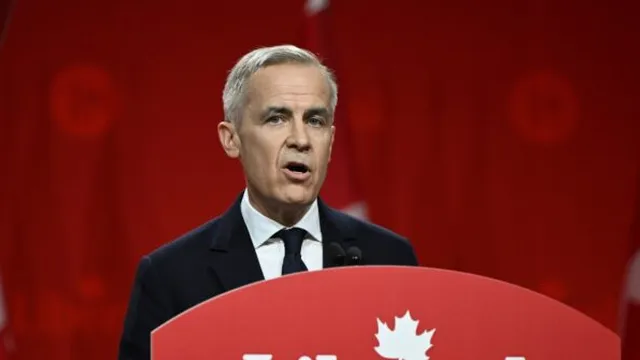
Mark Carney triggers early election in Canada amid trade war
2025-03-24 15:38- Mark Carney will dissolve Parliament and trigger an early election in Canada for April 28, 2025.
- The election is fueled by a crisis stemming from trade tensions with the U.S., particularly regarding sovereignty issues.
- The electoral landscape has shifted, as sentiments against the U.S. trade actions have bolstered support for Carney's Liberal Party.
Express your sentiment!
Insights
On March 23, 2025, Canadian Prime Minister Mark Carney is set to initiate an early parliamentary election. This decision comes as Canada grapples with significant challenges including a trade war sparked by U.S. President Donald Trump's tariffs and threatening rhetoric about Canadian sovereignty. The expected vote is scheduled for April 28, marking a critical moment for Carney, who has only recently taken office as the 24th prime minister of Canada following the resignation of Justin Trudeau in January 2025. This election may fundamentally reshape Canadian politics, especially considering the pressure from U.S. economic policies. The political landscape has shifted dramatically since Carney's appointment. The governing Liberal Party, which Carney leads, was facing what many anticipated to be a historic defeat against the Conservative Party, led by Pierre Poilievre. However, the trade tensions with the U.S. have bolstered nationalistic sentiments among Canadians, revitalizing support for the Liberals. This so-called 'Trump Effect' has transformed the electoral dynamic, positioning Carney to argue that he is uniquely equipped to handle the threats posed by the U.S. Throughout his career, Mark Carney has navigated economic crises, having previously served as the head of the Bank of Canada and later the Bank of England. However, his lack of political experience raises questions about his candidacy in this election. Conservatives had maintained a significant lead in polls prior to the escalation of trade tensions, and now the race is expected to closely revolve around who can effectively manage relations with the U.S. as well as domestic policies. As the election campaign kicks off, Carney's approach will be scrutinized, especially in light of Trump's aggressive stance towards Canada. He has indicated that he is willing to meet Trump but stressed the importance of respect for Canadian sovereignty. Following the dissolution of Parliament, all 338 members of the House of Commons will be voted for, which is crucial in determining the next government. The outcome will not only decide the prime minister but will also shape the future of Canada’s political and economic landscape in relation to its southern neighbor.
Contexts
Canada and the United States share one of the most comprehensive and mutually beneficial trade relationships in the world. This partnership is underpinned by geographical proximity, historical ties, and robust economic interdependence. The United States is Canada's largest trading partner, accounting for approximately 75% of Canadian exports and 50% of imports. In 2022, the total trade between the two nations reached over $650 billion, with key sectors including automotive, energy, machinery, and agriculture playing significant roles in bilateral trade dynamics. The trading relationship has been further strengthened by agreements such as the United States-Mexico-Canada Agreement (USMCA), which replaced the North American Free Trade Agreement (NAFTA) and aimed to enhance trade and economic cooperation by addressing issues such as labor rights, environmental standards, and intellectual property protection. The automotive industry exemplifies the connectivity between Canada and the U.S., as both countries have integrated supply chains that are vital to their economies. Many automobile manufacturers operate facilities in both nations, leading to a seamless flow of automotive parts and vehicles across the border. In addition, Canada is a crucial supplier of raw materials and energy resources such as oil and natural gas to the U.S. Energy cooperation is particularly significant, as Canada supplies nearly 90% of U.S. crude oil imports and is a strong partner in efforts to innovate and transition to cleaner energy sources. Tariffs and trade policies continue to evolve, posing both challenges and opportunities. Despite the relatively low levels of tariffs, trade disputes have emerged from time to time, often related to agricultural products and lumber, illustrating the complexities of the trade relationship. The continuous negotiations and adjustments reflect the dynamic nature of global trade, as both countries adapt to changing economic conditions, technological advancements, and shifts in geopolitical landscapes. A critical area of focus moving forward is the management of trade relations in light of environmental policies and sustainability goals, as both countries strive to promote economic growth while mitigating climate change impacts. Looking ahead, Canada and the U.S. have the opportunity to further deepen their trade collaboration by addressing emerging trends such as e-commerce, digital trade, and the impact of new technologies on traditional industries. Strengthening supply chain resilience and security will also be central to future trade discussions, especially considering the lessons learned from disruptions during the COVID-19 pandemic. Overall, the Canada-U.S. trade relationship is poised for continued growth, adapting to new challenges and leveraging shared interests to enhance economic prosperity for both nations.